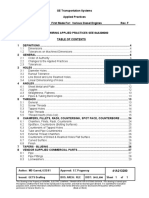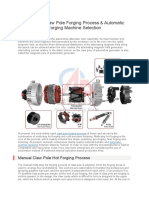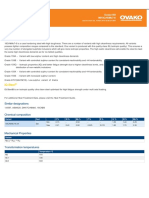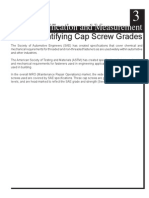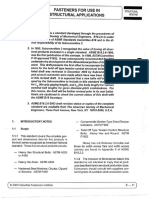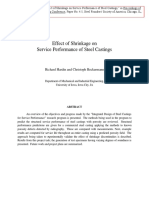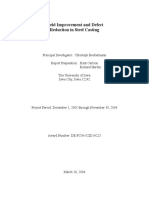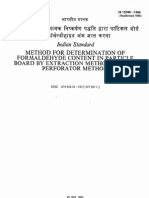GE Transportation: 3.may.2012 General Tolerance Specification Rev. D
GE Transportation: 3.may.2012 General Tolerance Specification Rev. D
Uploaded by
My Dad My WorldCopyright:
Available Formats
GE Transportation: 3.may.2012 General Tolerance Specification Rev. D
GE Transportation: 3.may.2012 General Tolerance Specification Rev. D
Uploaded by
My Dad My WorldOriginal Title
Copyright
Available Formats
Share this document
Did you find this document useful?
Is this content inappropriate?
Copyright:
Available Formats
GE Transportation: 3.may.2012 General Tolerance Specification Rev. D
GE Transportation: 3.may.2012 General Tolerance Specification Rev. D
Uploaded by
My Dad My WorldCopyright:
Available Formats
GE Transportation
3.May.2012 General Tolerance Specification Rev. D
1. SCOPE
This specification defines the general tolerances in the Imperial and Metric systems to be used on GE
Transportation parts and products. For cast and forged parts, see the 84A226035AB.
Unless otherwise explicitly specified on a drawing for a particular dimension or characteristic, or in
the title block of this drawing (only for legacy drawings), these general tolerances shall be applied to
all new drawings created after the revision A issue date of this specification. It shall also apply to all
drawings that are formally reissued after the revision A issue date of this specification.
Where the primary dimensions on the drawing are Imperial, the Imperial tolerances in this document
shall apply. Where the primary dimensions on the drawing are Metric, the Metric tolerances in this
document shall apply.
1.1. ORDER OF PRECEDENCE
The following order of precedence define how tolerances shall be applied:
1.1.1.1. Explicit Tolerances – any tolerances on the drawing face take precedence over any of
document or instruction invoked.
1.1.1.2. Industry Standards – Items such as sheet metal thickness, which are driven by other
industry standards (such as ASME or ASTM) specified on the drawing face.
1.1.1.3. Implicit Tolerances – any characteristics on the drawing face that do not carry explicit
tolerances shall derive their tolerances from this document. This excludes items such as
thickness, thread creation, etc which shall be driven from other specifications (ANSI,
ASA, etc) which regulate these features.
1.1.1.4. GE Standards – Any internal GE standard invoked on the drawing face (such as the
84A208000 Wiring Standard).
1.1.1.5. Under-defined - Any characteristics without a tolerance from any of the previous points
shall be considered under-defined and GET Engineering consultation shall be sought.
2. ABBREVIATIONS, DEFINITIONS, and REFERENCES
Abbreviations
GD&T Geometric Dimensioning and Tolerancing
GET GE Transportation
For additional tolerance and geometric control definitions and standards, please refer to the
84A222563AD, 84A222563AG and 84A222563AP.
Drafting Standards per the 84A222563 series of documents, which are based on the ASME Y14.5 –
1994 and ASME Y14.100 – 2004.
3. CONFIGURATION CONTROL and REVISION HISTORY
For changes to this specification or review cycle, please consult the Standard Work Practice labeled
as General Tolerance Practices.
Author: Engineering Approval: PE Roundtable 84A226035
Issued: GET Engineering BUS. AREA: All DIST: On-Line Sheet 1 of 6
This Drawing is the Property of GENERAL ELECTRIC COMPANY. This drawing is loaned upon the express condition that it shall not be
reproduced in any manner, and shall be returned upon demand. It is submitted for evaluation purposes and it, and the information contained
therein, shall not be otherwise used nor disclosed to third parties without written permission of General Electric Co.
GE Transportation
3.May.2012 General Tolerance Specification Rev. D
The content of this specification shall be formally reviewed within 1 year after the most recent
revision.
Table 3a – Revision History
Revision Release Date Author Summary
0 18.Dec.2009 FS Bekeny Initial release
A 12.Dec.2010 M McCullough Document rewritten to conform with ASME Y14.5M
1994
B 16.Dec.2010 M McCullough Update Torque Requirements
C 19.Apr.2010 Add mfging best practices, clarify undercuts / burrs
D 3.May.2012 Clarify section 7
4. TOLERANCES FOR DIMENSIONAL CHARACTERISTICS
Dimensional characteristics are defined to include but not limited to:
• External linear dimensions
• Internal linear dimensions
• Diameters and radii of holes
• Radii (internal and external)
• Distances
• Chamfers
Table 4a – Tolerances for Dimensional Characteristics (Units in millimeters)
Tolerance class Tolerances for Nominal Dimension within Listed Range
over over over over over over over
Designation Description 0.50 3 6 30 120 400 1000 2000
up to up to up to up to up to up to up to up to
3 6 30 120 400 1000 2000 4000
f fine ±0.05 ±0.05 ±0.10 ±0.15 ±0.20 ±0.30 ±0.50 -
m medium ±0.10 ±0.10 ±0.20 ±0.30 ±0.50 ±0.80 ±1.20 ±2
c coarse ±0.20 ±0.30 ±0.50 ±0.80 ±1.20 ±2 ±3 ±4
vc very coarse - ±0.50 ±1 ±1.50 ±2.50 ±4 ±6 ±8
Table 4b – Tolerances for Dimensional Characteristics (Units in inches)
Tolerance class Tolerances for Nominal Dimension within Listed Range
over over over over over over over
Designation Description .02 .12 .25 1.0 5.0 15.0 40.0 80.0
up to up to up to up to up to up to up to up to
.12 .25 1.0 5.0 15.0 40.0 80.0 160.0
f fine ±.002 ±.002 ±.004 ±.006 ±.008 ±.012 ±.020 -
m medium ±.004 ±.004 ±.008 ±.012 ±.020 ±.032 ±.050 ±.080
c coarse ±.008 ±.012 ±.020 ±.032 ±.050 ±.080 ±.120 ±.160
vc very coarse - ±.020 ±.040 ±.060 ±.100 ±.160 ±.250 ±.320
Note that for values less than 0.50 millimeters or 0.02 inches; explicit tolerances on the drawing face are required.
Author: Engineering Approval: PE Roundtable 84A226035
Issued: GET Engineering BUS. AREA: All DIST: On-Line Sheet 2 of 6
This Drawing is the Property of GENERAL ELECTRIC COMPANY. This drawing is loaned upon the express condition that it shall not be
reproduced in any manner, and shall be returned upon demand. It is submitted for evaluation purposes and it, and the information contained
therein, shall not be otherwise used nor disclosed to third parties without written permission of General Electric Co.
GE Transportation
3.May.2012 General Tolerance Specification Rev. D
While no reference to the document shall be made, the values used in Table 4a align with the ISO 2768-1
(as released in 2009). The values used in Table 4b are the Imperial equivalent to Table 4a.
The default for all drawings shall be the Medium designation unless another is desired by Engineering.
To invoke another classification, simply change the callout on the drawing from a –m to the desired
designation. To restate, if the Default Tolerance on the drawing face reads “84A226035” and does not
carry a designation then that shall be considered 84A226035-m.
Recommendations:
• Fine - No known application at GET to date.
• Medium - Machined components.
• Coarse - Assemblies of moving parts.
• Very Coarse - Sheet metal, pipe, non-critical assemblies.
For cast and forged parts, see the 84A226035AB.
When a new drawing is created, the following shall be the default tolerance class applied unless
otherwise specified by engineering.
Defaults by business:
• Locomotive – vc
• Control – vc
• Off Highway (OHV) – vc
• Energy Storage – vc
• Locomotive Engine & Generator Sets – m
• Marine Engine – m
• Wind – m
• Propulsion – c
5. ANGULAR DIMENSION TOLERANCES
All angles shall be +/- 1°.
6. SURFACE TEXTURE TOLERANCES
There are no general tolerances for surface texture. Surface texture tolerances, when required, shall
be explicitly documented on the drawing in accordance with the ASME Y14.36 - 1996.
Surface textures are typically documented as follows:
xxx
For Metric xxx is the micrometer measurement. The default maximum finish value is 6.3.
Author: Engineering Approval: PE Roundtable 84A226035
Issued: GET Engineering BUS. AREA: All DIST: On-Line Sheet 3 of 6
This Drawing is the Property of GENERAL ELECTRIC COMPANY. This drawing is loaned upon the express condition that it shall not be
reproduced in any manner, and shall be returned upon demand. It is submitted for evaluation purposes and it, and the information contained
therein, shall not be otherwise used nor disclosed to third parties without written permission of General Electric Co.
GE Transportation
3.May.2012 General Tolerance Specification Rev. D
For Imperial xxx is the microinch measurement. The default maximum finish value is 250.
As for tolerancing, this finish value shall be considered a maximum value. In that if a finish of 125
micro-inches is specified then the roughest the part may be is 125 microinches but it could be
smoother. Where it is desired to strictly limit the range, this shall be explicitly listed on the drawing.
The following table provides a correspondence between metric arithmetical mean deviation (Ra), its
Imperial equivalent, and the roughness grade number. These are not direct conversions but rather
should be used as similar to. 50µm is similar to 2,000 µin which is also similar to N12.
Table 6a – Correspondence of Arithmetical Mean Deviation Ra and Roughness Grade Numbers
Roughness Values Ra
Roughness Grade Numbers
micrometers microinches
50 2000 N12
25 1000 N11
12.5 500 N10
6.3 250 N9
3.2 125 N8
1.6 63 N7
0.8 32 N6
0.4 16 N5
0.2 8 N4
0.1 4 N3
0.05 2 N2
0.025 1 N1
Author: Engineering Approval: PE Roundtable 84A226035
Issued: GET Engineering BUS. AREA: All DIST: On-Line Sheet 4 of 6
This Drawing is the Property of GENERAL ELECTRIC COMPANY. This drawing is loaned upon the express condition that it shall not be
reproduced in any manner, and shall be returned upon demand. It is submitted for evaluation purposes and it, and the information contained
therein, shall not be otherwise used nor disclosed to third parties without written permission of General Electric Co.
GE Transportation
3.May.2012 General Tolerance Specification Rev. D
7. CORNERS, BURRS, UNDERCUTS
ITEM DRAFTING AND MANUFACTURING PRACTICE
(A) Chamfer tolerances should be specified on the drawing face or per 84A226035.
Chamfer
(B) Unless otherwise Diameter Chamfer
Break Corner stated on the drawing, Up to 1" (25.4mm) 0.005 to 0.02 (0.127mm – 0.508mm)
break all corners on Over 1" to 2" (25.4mm – 0.005 to 0.04 (0.127mm – 1.016mm)
machined diameters or 50.8mm) 0.005 to 0.06 (0.127 – 1.524mm)
faces with a chamfer or Over 2" (50.8mm)
radius.
(C) Must be stated on drawing as "Sharp Corner" and have a maximum radius of 0.005 (0.127mm).
Sharp Corner
Radius Corner - (R) Specify on drawings only when a chamfer is not acceptable. Unless otherwise specified, radii of
or Fillet - (F) corners to be:
no radii specified -- See "B"
radii - specify on drawing = ± .02 (0.508mm)
(H) Specified per 84A226035.
Under-cut
(K) End projections on part-off cuts must be removed unless otherwise specified.
Part off
Thread Undercut Undercut diameter must be shown when thread is carried up to head undercut.
8. TORQUE
Torque tolerance shall be +/- 5% from the nominal value specified on the drawing. Where a torque
specification is used, that document shall take precedence over this one and +/- 5% shall only apply
where that document does not cover the full engineering definition.
Any torqueing requirements not specified on the drawing shall be considered under-defined.
9. MANUFACTURING BEST PRACTICES
9.1. GENERAL PRACTICES
Author: Engineering Approval: PE Roundtable 84A226035
Issued: GET Engineering BUS. AREA: All DIST: On-Line Sheet 5 of 6
This Drawing is the Property of GENERAL ELECTRIC COMPANY. This drawing is loaned upon the express condition that it shall not be
reproduced in any manner, and shall be returned upon demand. It is submitted for evaluation purposes and it, and the information contained
therein, shall not be otherwise used nor disclosed to third parties without written permission of General Electric Co.
GE Transportation
3.May.2012 General Tolerance Specification Rev. D
All applicable manufacturing best practices shall be used unless prohibitive or otherwise specified
on the drawing. Manufacturing best practices can be found in the 84A226035AC.
9.2. WIRING
Wiring best practices can be found in the 84A208000. Any drawing detailing wiring design / routing
shall follow this document.
10. APPLIED PRACTICES AND STANDING INSTRUCTIONS
While these documents shall not be used on the drawing face any longer as default tolerances, they
can be used to derive what the tolerance was / should be if the values in this document are not
acceptable for a particular feature or part – they are reference only. In that instance, it is
recommended to derive what the tolerance would be based on the applied practice and then explicitly
define that value on the drawing face. A list of known documents is shown here. Note that the
standards listed were the most commonly used; this is not an exhaustive list.
Business
Standard Number Description
Locomotive Engine Control Propulsion Wind OHV M&S Genset
41A282000 x General Assembly
84A208000 x x x Wiring
41A213278 x x General Assembly
41A213279 x x Casting Tolerances
41A213280 x x Machining Tolerances
SI-10359 x x Standard that covers all manufacturing
SI-10350 x x Bus Bar Insulation
SI-10559 x x List of processes for Finishes and Coatings
SI-10025 x Standard that covers all manufacturing
SI-10348 x Wiring & assemblies
SI-10027 x Bolt Torque
C50E76 x Material Testing
C50E82 x x Material Testing
K4015012 x x Knurling
ISO 2768-1-m x x General Machining Tolerances
ISO 2768-2-K x x General Machining Tolerances
ISO 4287 x x Theoretical Surface Texture Definitions
ISO 4288 x x Theoretical Surface Texture Definitions
ISO 13715 x x Edges of Undefined Shape
ISO 286-1 x x Interpreting Dimensions
ISO 286-2 x x Interpreting Dimensions
499A981AA x Pipe Bending Design Guidelines Bldg 10
84A216320 x Light Fabircation Guidelines
84A216320AB x Heavy fabrication Guidelines
B30E501 x
B30E5 x Mat'l Comp, Dimensions & Tolerances
B50E147A x Tubing
B50E147 x Tubing Dimensions & Tolerances
84D740043AC x Various Torques (GEVO)
K5903487 x x Tap Depth
84A224379 x x Critical Fasteners
M9946126 x Tap Drill Sizes
41C633023 x Counterbore and Spotfacing
84A225834-mK x ISO 2768-mK
84D740043 x x Various Torques (Generic)
84D740043AB x x Various Torques (????)
SI-10013 x Gear Casing
SI-10017 x Painting Machined Assemblies
SI-10011 x Mounting Pinions
SI-10008 x Motor Frame Parts
C50E90 x x Crankshaft Specification
C50E73 x x Steel Castings
Author: Engineering Approval: PE Roundtable 84A226035
Issued: GET Engineering BUS. AREA: All DIST: On-Line Sheet 6 of 6
This Drawing is the Property of GENERAL ELECTRIC COMPANY. This drawing is loaned upon the express condition that it shall not be
reproduced in any manner, and shall be returned upon demand. It is submitted for evaluation purposes and it, and the information contained
therein, shall not be otherwise used nor disclosed to third parties without written permission of General Electric Co.
You might also like
- 84 A 226035Document6 pages84 A 226035Herman33% (3)
- DIN EN 10293: April 2015Document21 pagesDIN EN 10293: April 2015My Dad My World67% (3)
- SAE J1390-2017 Engine Cooling Fan Structural AnalysisDocument18 pagesSAE J1390-2017 Engine Cooling Fan Structural AnalysisProvocateur SamaraNo ratings yet
- Author: MD Garred, 6/22/61 Approval: EC Przypsnzy Issued: GETS Drafting Bus. Area: Rle Dist: Sheet 1 of 1Document47 pagesAuthor: MD Garred, 6/22/61 Approval: EC Przypsnzy Issued: GETS Drafting Bus. Area: Rle Dist: Sheet 1 of 1My Dad My WorldNo ratings yet
- GE Quality Requirements For Heavy Wind Mill CastingsDocument9 pagesGE Quality Requirements For Heavy Wind Mill CastingsMy Dad My WorldNo ratings yet
- Predictive/Preventive Maintenance (PPM) : The Tissue Converter's Guide ToDocument5 pagesPredictive/Preventive Maintenance (PPM) : The Tissue Converter's Guide ToJuanNo ratings yet
- Sheet Metal Forming: Formability & Forming LimitsDocument53 pagesSheet Metal Forming: Formability & Forming Limitsamit gajbhiyeNo ratings yet
- Iso 14 1982Document10 pagesIso 14 1982LotharSchmidtNo ratings yet
- SAEJ198 V 001Document12 pagesSAEJ198 V 001Nijanthan G. VasudevanNo ratings yet
- Carbon Steel Forgings, Class 2: Corporate Purchase Specification AA 193 31 Rev. No. 11 Preface SheetDocument7 pagesCarbon Steel Forgings, Class 2: Corporate Purchase Specification AA 193 31 Rev. No. 11 Preface Sheetraghav248No ratings yet
- Ind0101 - GDocument4 pagesInd0101 - Grajit kumarNo ratings yet
- B4E4Document3 pagesB4E4Himanshu MishraNo ratings yet
- Iso 683 2 2016Document13 pagesIso 683 2 2016Ram KumarNo ratings yet
- Iso 3098 1 2015Document9 pagesIso 3098 1 2015Burak Yılmaz0% (1)
- Tower Bolts - Specification: Indian StandardDocument12 pagesTower Bolts - Specification: Indian StandardRamesh MankaniNo ratings yet
- Bolt Strength PDFDocument1 pageBolt Strength PDFhlsimonNo ratings yet
- 4) ASTM A29 GR 4130 PDFDocument1 page4) ASTM A29 GR 4130 PDFchandraNo ratings yet
- Surface Roughness JIS B 0601 (1994)Document1 pageSurface Roughness JIS B 0601 (1994)Tú Nguyễn MinhNo ratings yet
- Claw Pole Forging ProcessDocument8 pagesClaw Pole Forging ProcessBhagat SinghNo ratings yet
- Is 5429Document7 pagesIs 5429Yogesh RohillaNo ratings yet
- IS 513 Grade EDDDocument2 pagesIS 513 Grade EDDRamji GautamNo ratings yet
- Portable EDM MachineDocument10 pagesPortable EDM Machinedarshan.dd.21.demeNo ratings yet
- VW - TL 217 - en - 01Document8 pagesVW - TL 217 - en - 01Gabriel MesquitaNo ratings yet
- Bi-Metal BearingsDocument20 pagesBi-Metal BearingsRitz AmbyyNo ratings yet
- ISO 8750 DIN 7343 420-545 HV: Spiral Spring PinsDocument4 pagesISO 8750 DIN 7343 420-545 HV: Spiral Spring PinsViswanathan SrkNo ratings yet
- VDI3345Document9 pagesVDI3345Cássio HerediaNo ratings yet
- Saej 10 V 003Document4 pagesSaej 10 V 003neojfbNo ratings yet
- Standard - Material TSG3580G_10_P_1_200708 (1)Document18 pagesStandard - Material TSG3580G_10_P_1_200708 (1)Guilherme BackNo ratings yet
- Iso898 2Document19 pagesIso898 2Ricardo VitorianoNo ratings yet
- Colly Pop Rivet 222Document95 pagesColly Pop Rivet 222Andreas LidströmNo ratings yet
- En 353Document3 pagesEn 353anush_swaminathanNo ratings yet
- ASM Material Data SheetDocument2 pagesASM Material Data SheetShankar PranavNo ratings yet
- Hes B040 Flange Head BoltDocument18 pagesHes B040 Flange Head BoltParvendar ratheeNo ratings yet
- TFS BrochureDocument178 pagesTFS Brochureewqeq100% (1)
- Saej1453 2v001Document75 pagesSaej1453 2v001PANKAJ CHAUHANNo ratings yet
- Sae j429. Vs Astm A354 BDDocument2 pagesSae j429. Vs Astm A354 BDOswaldo Leyva RNo ratings yet
- Summer Training Report On "Control and Working of Metro Rail"Document61 pagesSummer Training Report On "Control and Working of Metro Rail"KshitijKumar100% (1)
- Ford Wa 960-2004Document1 pageFord Wa 960-2004DanielMa0% (1)
- Round Wire Snap Ring and Snap Ring Groove For Shafts: DIN 9925, Steel, PlainDocument2 pagesRound Wire Snap Ring and Snap Ring Groove For Shafts: DIN 9925, Steel, Plainsidik shanksNo ratings yet
- EN 16983 (Ex DIN 2093) Dim 1Document7 pagesEN 16983 (Ex DIN 2093) Dim 1Roby MastreNo ratings yet
- Root and Face Bend TestsDocument3 pagesRoot and Face Bend TestsErlinawati Bintu SupiyoNo ratings yet
- B7A13Document5 pagesB7A13Himanshu MishraNo ratings yet
- Astm A29 A29m (1999)Document22 pagesAstm A29 A29m (1999)sekarNo ratings yet
- Asme B18.2.6 2003Document11 pagesAsme B18.2.6 2003Jesse ChenNo ratings yet
- Iso 4017Document1 pageIso 4017Nuno Miguel TorcatoNo ratings yet
- Aida-StandardsDocument14 pagesAida-StandardsthaivinhtuyNo ratings yet
- REAR AXLE (Single Tyre)Document4 pagesREAR AXLE (Single Tyre)MochamadIsmail Ninjutsu FromhellNo ratings yet
- Tolerances and FitsDocument20 pagesTolerances and FitsDrmanal Amin100% (1)
- TM 10 6630 233 13 and P PDFDocument39 pagesTM 10 6630 233 13 and P PDFJulio Cesar RoaNo ratings yet
- ADC12Document8 pagesADC12naganna pNo ratings yet
- Fits and LimitsDocument5 pagesFits and LimitsAbdulai WakoNo ratings yet
- Astm A193 A193m 23Document7 pagesAstm A193 A193m 23huicholeNo ratings yet
- DIP Soldering Review Specs 20220515Document2 pagesDIP Soldering Review Specs 20220515LokNo ratings yet
- ISO-281-2-2008 Corrigendum-2009Document3 pagesISO-281-2-2008 Corrigendum-2009antonioNo ratings yet
- Iso Metric 32Document2 pagesIso Metric 32rahul caddNo ratings yet
- 0803 - John Deere - Casting Repairing InstructionsDocument4 pages0803 - John Deere - Casting Repairing Instructionscrazy dNo ratings yet
- Is 1079 - 2009Document10 pagesIs 1079 - 2009Shradha SinghaniaNo ratings yet
- 2016 - Plain Washer PDFDocument16 pages2016 - Plain Washer PDFNagesh Chopade100% (2)
- En Aw-6082 (Aisi1mgmn)Document1 pageEn Aw-6082 (Aisi1mgmn)Vanessa Gomes100% (1)
- ISO System of Limits and Fits (Tolerances)Document6 pagesISO System of Limits and Fits (Tolerances)skakerNo ratings yet
- DWGB106Document6 pagesDWGB106LucaNo ratings yet
- A615A615M Vbyv3593Document8 pagesA615A615M Vbyv3593Aris ComilangNo ratings yet
- ASTM-B90-B90M-13 Standard Specification For Magnesium-Alloy Sheet and PlateDocument8 pagesASTM-B90-B90M-13 Standard Specification For Magnesium-Alloy Sheet and Plateatishr100% (1)
- Informative Annex 2 - Surface FinishDocument10 pagesInformative Annex 2 - Surface FinishzaheerNo ratings yet
- Iso 4992-1Document36 pagesIso 4992-1My Dad My WorldNo ratings yet
- Revision HistoryDocument31 pagesRevision HistoryMy Dad My WorldNo ratings yet
- Eil Qap-2012Document5 pagesEil Qap-2012My Dad My WorldNo ratings yet
- Quality Feed Back Report: Part Name Main HSG Supplier M/S.PCPL Qty 02 NosDocument1 pageQuality Feed Back Report: Part Name Main HSG Supplier M/S.PCPL Qty 02 NosMy Dad My WorldNo ratings yet
- PPAP - 4th Edition - Course MaterialDocument18 pagesPPAP - 4th Edition - Course MaterialMy Dad My WorldNo ratings yet
- APQPDocument18 pagesAPQPMy Dad My World100% (1)
- Caterpillar Cost of Poor Quality (Copq) AgreementDocument6 pagesCaterpillar Cost of Poor Quality (Copq) AgreementMy Dad My WorldNo ratings yet
- Dross Inclusions in An Iron Foundry PDFDocument4 pagesDross Inclusions in An Iron Foundry PDFMy Dad My World100% (1)
- 2002-4.5 Effect of Shrinkage PDFDocument29 pages2002-4.5 Effect of Shrinkage PDFMy Dad My WorldNo ratings yet
- Dross Inclusions in An Iron Foundry PDFDocument4 pagesDross Inclusions in An Iron Foundry PDFMy Dad My World100% (1)
- Yield Improvement Steel Castings PDFDocument321 pagesYield Improvement Steel Castings PDFMy Dad My WorldNo ratings yet
- 2002-4.5 Effect of Shrinkage PDFDocument29 pages2002-4.5 Effect of Shrinkage PDFMy Dad My WorldNo ratings yet
- CoatingsDocument8 pagesCoatingsMy Dad My WorldNo ratings yet
- How To Start A WordPress E Commerce Site Using WooCommerce Slides PDFDocument106 pagesHow To Start A WordPress E Commerce Site Using WooCommerce Slides PDFIsnanto Nugroho100% (1)
- Serial Data Display: Read Instructions Carefully !Document14 pagesSerial Data Display: Read Instructions Carefully !Digitaladda IndiaNo ratings yet
- RISE ON - FALL ON - AflDocument3 pagesRISE ON - FALL ON - AflRajen Vyas100% (1)
- OCIMF Hot Work PDFDocument9 pagesOCIMF Hot Work PDFiomerko100% (1)
- Fan TKV025Document80 pagesFan TKV025arifin.ade4riNo ratings yet
- Flossmetrics Final Report: Free/Libre/Open Source Metrics and BenchmarkingDocument35 pagesFlossmetrics Final Report: Free/Libre/Open Source Metrics and BenchmarkingVasileios VasilakakisNo ratings yet
- Atpg GD PDFDocument400 pagesAtpg GD PDFJayesh Bagda100% (1)
- CV & Portfolio Haroon Iqbal - HAROON IQBALDocument7 pagesCV & Portfolio Haroon Iqbal - HAROON IQBALkoi naiNo ratings yet
- Presentation - Slum Department 21st Sept 2010Document42 pagesPresentation - Slum Department 21st Sept 2010Nupur Bhadra100% (1)
- K To 12 Entrep-Based Technical Drafting Learning Module PDFDocument40 pagesK To 12 Entrep-Based Technical Drafting Learning Module PDFMixengxeng Ü EspinosaNo ratings yet
- 646A231 GB 03 1108wDocument24 pages646A231 GB 03 1108wMiguel ParedesNo ratings yet
- LS Retail NAV 2009.1 (6.1) New Features 02Document43 pagesLS Retail NAV 2009.1 (6.1) New Features 02Felix NasirNo ratings yet
- Appendix 1 Ertms (En)Document13 pagesAppendix 1 Ertms (En)Chaithan KumarNo ratings yet
- Study of Awareness of Welfare Schemes and Working Conditionsat Ashok Leyland, Pantnagar, UttarakhandDocument11 pagesStudy of Awareness of Welfare Schemes and Working Conditionsat Ashok Leyland, Pantnagar, UttarakhandRohit KumarNo ratings yet
- Ibm Thinkpad I Series 1400,1500Document172 pagesIbm Thinkpad I Series 1400,1500Luis TavisNo ratings yet
- Msds LDPEDocument19 pagesMsds LDPEAndre RachmanNo ratings yet
- Lost Foam Casting Process - Heavy CastingsDocument15 pagesLost Foam Casting Process - Heavy CastingsGurudutta Mishra100% (1)
- Age of Information TechnologyDocument4 pagesAge of Information TechnologyKenneth MarcosNo ratings yet
- DDL DML DQL TCL DCL Practice1Document9 pagesDDL DML DQL TCL DCL Practice1D-suman50% (4)
- sp4409 Vol2Document565 pagessp4409 Vol2Ade YahyaNo ratings yet
- PQR FormatDocument2 pagesPQR FormatBE GNo ratings yet
- Perno A325 HDG 5-8 X 1 1-2 (JN+6654225)Document1 pagePerno A325 HDG 5-8 X 1 1-2 (JN+6654225)Alexander Ortiz CarrionNo ratings yet
- 13745Document10 pages13745Binayak KumarNo ratings yet
- Perfect Oil Seals & I.R.P.: Fifo Process FlowDocument3 pagesPerfect Oil Seals & I.R.P.: Fifo Process FlowJitendra ShindeNo ratings yet
- Top 10 Risks in Aerospace!Document34 pagesTop 10 Risks in Aerospace!Matasaru Alexandru Dumitru100% (2)
- Selden Yacht Catalogue MarineriggingDocument101 pagesSelden Yacht Catalogue MarinerigginglmarinegroupNo ratings yet
- Analysis On The Defects of Loose and Under Cast Thin Wall Castings - ZHY CastingDocument2 pagesAnalysis On The Defects of Loose and Under Cast Thin Wall Castings - ZHY CastingashokjkhannaNo ratings yet
- Simulationlab DO's &DON'TDocument6 pagesSimulationlab DO's &DON'TAshok DaraNo ratings yet
- BioZone Scientific Mini PowerZone Owners Manual1Document9 pagesBioZone Scientific Mini PowerZone Owners Manual1thaitruong26No ratings yet



